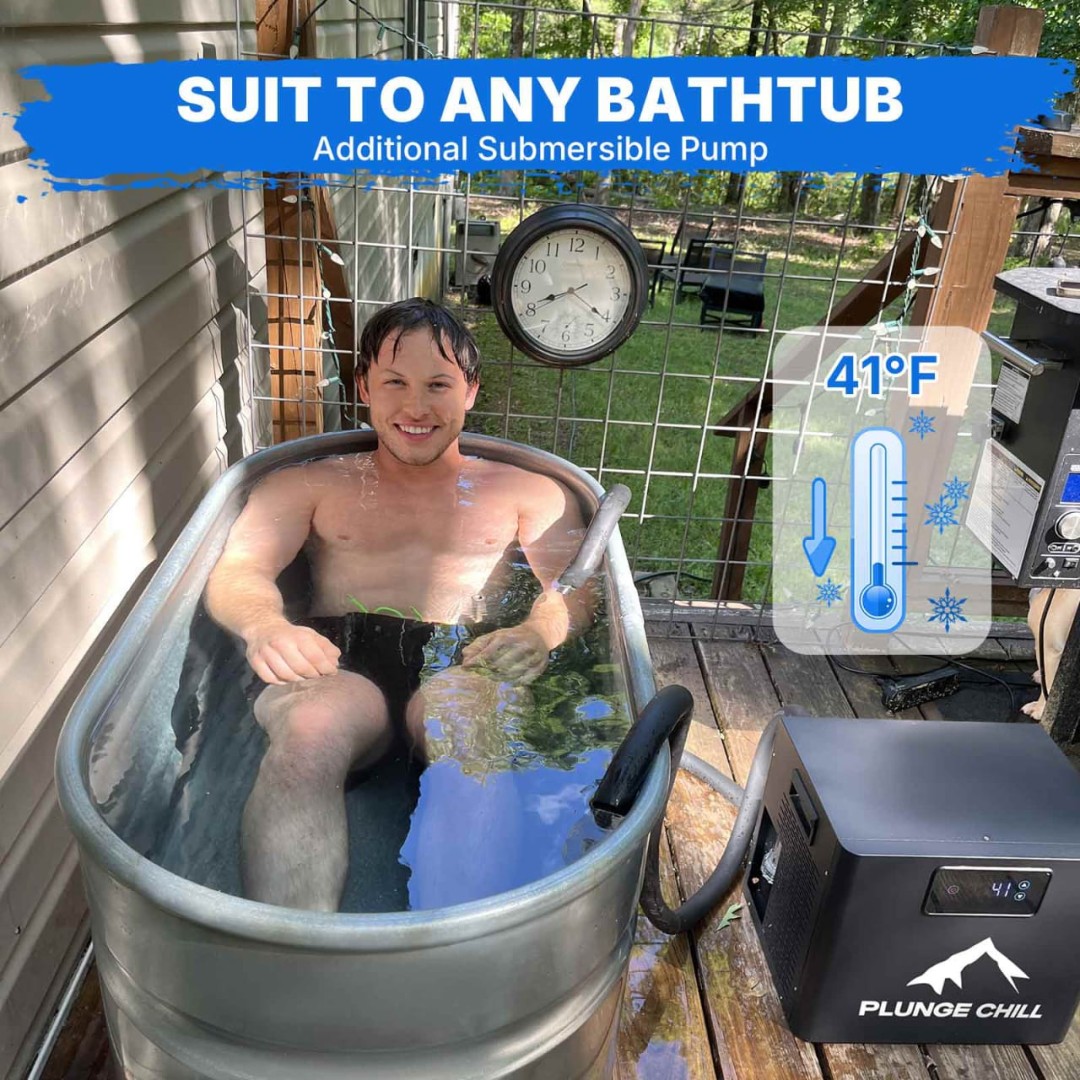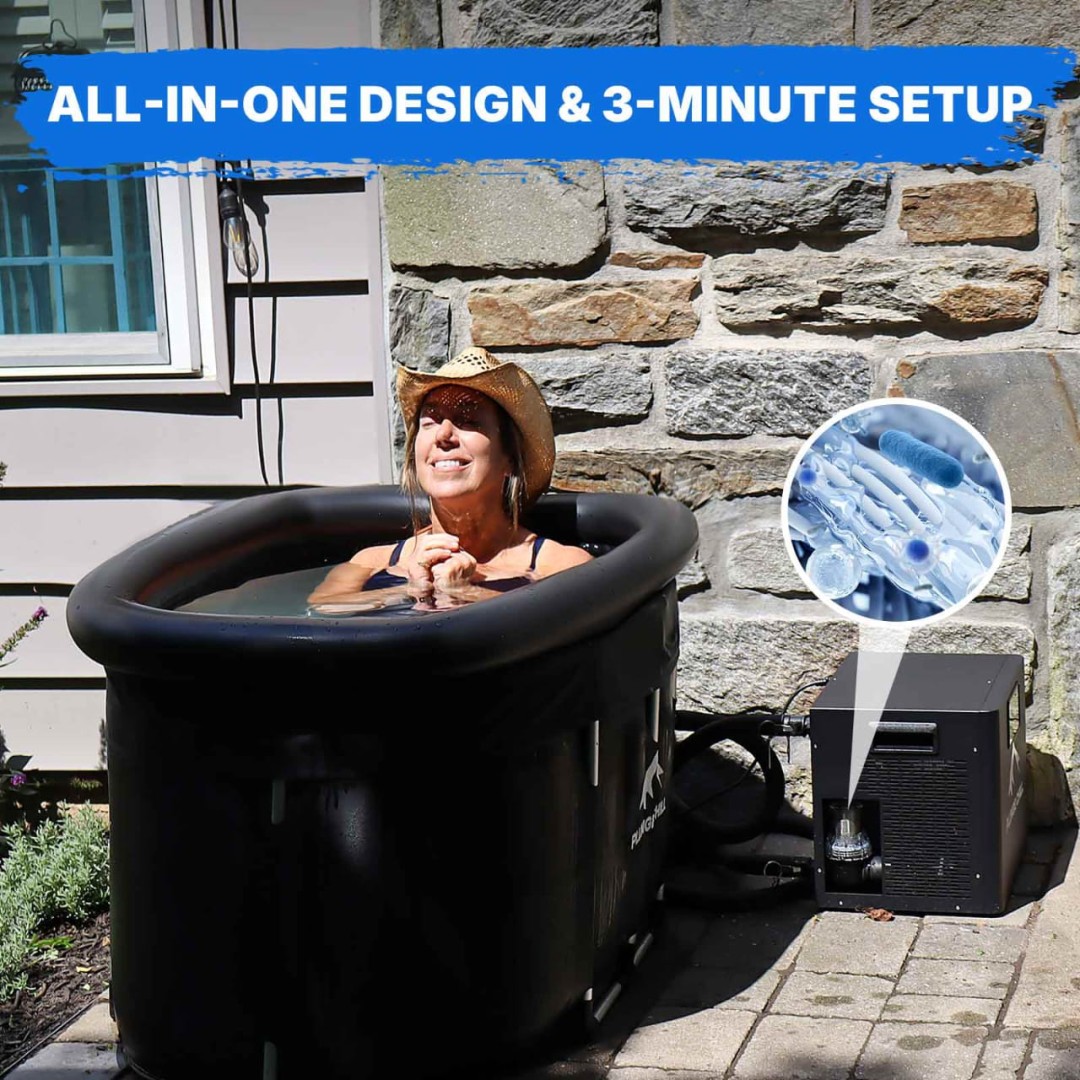Picture an athlete emerging from an ice-cold tub, steam rising from their skin, muscles relaxed and mind sharpened. This isn’t just a recovery ritual—it’s cold therapy, a wellness practice gaining momentum among fitness enthusiasts, biohackers, and health-conscious individuals worldwide. Cold plunge tubs have become essential tools for those seeking peak performance and enhanced recovery, offering controlled exposure to therapeutic cold temperatures. Yet traditional methods of filling tubs with bags of ice present obvious challenges: inconsistent temperatures, constant ice purchases, and the hassle of manual preparation. Enter plunge chillers, sophisticated systems that maintain precise water temperatures without the ice-buying routine. These modern solutions deliver consistent cold therapy benefits, from accelerated muscle recovery to reduced inflammation, transforming how we approach wellness. Whether you’re an athlete optimizing performance or someone exploring natural health strategies, understanding cold plunge systems opens doors to transformative recovery experiences that fit seamlessly into daily routines.
Why Cold Therapy Transforms Wellness Recovery
Cold therapy triggers profound physiological responses that extend far beyond simple muscle cooling. When your body encounters cold water, blood vessels constrict and then rapidly dilate upon warming, flushing metabolic waste while delivering oxygen-rich blood to damaged tissues. This vascular exercise accelerates muscle repair after intense training sessions, with research showing reduced delayed-onset muscle soreness by up to 20% compared to passive recovery. Inflammation markers drop significantly as cold temperatures slow cellular metabolism and limit secondary tissue damage from exercise-induced stress. Beyond physical benefits, cold exposure activates the sympathetic nervous system, releasing norepinephrine that sharpens mental clarity and elevates mood for hours afterward. Regular practitioners report decreased anxiety levels and improved stress resilience, as the controlled discomfort builds psychological fortitude. Elite athletes have documented faster return-to-training times, with some professional teams integrating daily cold plunges into standard protocols. Traditional recovery methods like static stretching or foam rolling address localized areas, but cold therapy delivers systemic benefits affecting circulation, nervous system function, and hormonal balance simultaneously. The practice essentially hijacks evolutionary survival mechanisms, converting short-term stress into long-term adaptation. This explains why wellness recovery through cold exposure produces results that passive rest simply cannot match, making it a cornerstone practice for anyone serious about optimizing physical and mental performance.

Cold Plunge Chillers: Your Ultimate Cold Therapy Solution
Cold plunge chillers eliminate the endless ice-buying cycle that plagues traditional cold therapy setups. Unlike dumping fifty pounds of ice into a tub twice weekly—an expensive, inconsistent method that struggles to maintain target temperatures—chillers use refrigeration technology to cool water continuously and precisely. These systems consist of a compressor unit, heat exchanger, and circulation pump that work together to extract heat from water, maintaining temperatures between 39-55°F with digital accuracy. The chiller connects directly to your cold plunge tub through inlet and outlet ports, circulating water through the cooling mechanism before returning it chilled. This closed-loop system ensures uniform temperature throughout the entire tub, eliminating cold spots that occur with melting ice. Within hours of activation, your plunge reaches therapeutic temperatures and holds them indefinitely, ready whenever your recovery schedule demands. The consistency transforms your cold therapy practice from a logistical challenge into an effortless routine—no more emergency ice runs or waiting for water to cool sufficiently for effective treatment.

Choosing Your Ideal Cold Plunge SetupChiller Selection Criteria
Matching chiller capacity to your tub volume determines system effectiveness. Calculate your tub’s gallon capacity and select a chiller rated to cool that volume within 4-6 hours—undersized units run constantly without reaching target temperatures, while oversized models waste energy and money. Energy efficiency ratings directly impact operating costs, with newer inverter-driven compressors reducing electricity consumption by 30-40% compared to older fixed-speed models. Noise output matters significantly if your setup occupies indoor spaces or near living areas; quality chillers operate at 45-55 decibels, comparable to quiet conversation, while budget units may produce disruptive 70+ decibel hums. Initial investment feels substantial, but calculate long-term value by comparing five years of ice purchases against chiller costs—most systems pay for themselves within 18-24 months while delivering superior temperature control.
Tub Options Compared
Pre-built cold plunge tub systems offer plug-and-play convenience with integrated filtration and insulation, ideal for those prioritizing immediate setup over customization. Custom-built tubs using stock tanks or repurposed containers cost less upfront but require separate filtration systems and insulation measures to maintain efficiency. Material selection impacts durability and maintenance—stainless steel resists corrosion and handles outdoor elements better than acrylic, though acrylic provides superior insulation and lighter weight for indoor installations. Size considerations extend beyond physical space; solo users function well with 80-100 gallon tubs allowing comfortable submersion, while couples or families benefit from 150-200 gallon models. Your ice plunge experience improves dramatically with proper depth—minimum 30 inches allows shoulder submersion, the threshold where cold therapy benefits fully activate through complete torso exposure.
Step-by-Step Cold Plunge Setup Guide
Begin by selecting a level surface that supports your filled tub’s weight—calculate total load by adding tub weight plus water (8.34 pounds per gallon) plus user weight, ensuring floors handle this combined mass or choosing reinforced outdoor platforms. Position your setup near electrical outlets rated for your chiller’s amperage requirements, typically 15-20 amps for residential units, and ensure adequate ventilation around the chiller to prevent overheating. Connect the chiller to your tub using the provided hoses, securing inlet and outlet fittings with hose clamps to prevent leaks, then fill the tub to manufacturer-specified levels before powering the system. Install a basic filtration system with a cartridge filter rated for your water volume, running it 2-4 hours daily to remove debris and maintain water clarity between monthly drains. Add water treatment chemicals sparingly—hydrogen peroxide or mineral sanitizers work better than chlorine for cold water, as low temperatures reduce chlorine effectiveness while causing skin irritation. Calibrate your chiller’s digital thermostat by setting your target temperature, typically 50°F for beginners, allowing 4-6 hours for initial cooldown while monitoring with a separate thermometer to verify accuracy. Complete your safety checklist by installing GFCI protection on electrical connections, placing non-slip mats around entry points, and keeping emergency shutoff switches accessible—these precautions prevent electrical hazards and reduce slip risks on wet surfaces surrounding your cold plunge area.
Beginner’s Roadmap to Your First Ice PlungeSafe Initiation Protocol
Start your cold therapy journey at 60°F rather than jumping immediately to frigid temperatures—this gentler introduction allows your nervous system to adapt without triggering panic responses that cause hyperventilation or early exit. Spend just two minutes in your first session, focusing entirely on controlled breathing rather than duration goals, as breath mastery determines whether cold exposure feels torturous or manageable. Decrease water temperature by 2-3 degrees weekly once you comfortably complete five-minute sessions at your current setting, giving your body time to build cold adaptation without overwhelming stress responses. Master box breathing before entering: inhale for four counts, hold for four, exhale for four, hold for four, repeating this pattern to activate parasympathetic calming that counteracts the cold shock response. This measured progression prevents the discouragement that derails beginners who start too aggressively, building genuine resilience instead of forcing uncomfortable endurance.
Building Routine Consistency
Commit to three sessions weekly during your first month, spacing them with rest days that allow nervous system recovery while establishing habit formation. Morning plunges deliver maximum alertness benefits as norepinephrine release carries through your entire day, though post-workout timing accelerates muscle recovery when inflammation peaks. Track your ice plunge experience in a simple journal noting temperature, duration, and subjective difficulty ratings—visible progress combats the mental resistance that surfaces before each session. The initial discomfort never fully disappears, but your relationship with it transforms; by week four, most practitioners report anticipating the energized clarity that follows rather than dreading the cold itself. Anchor your routine to existing habits like morning coffee preparation, using environmental cues that trigger automatic cold plunge initiation rather than relying on fluctuating motivation.
Optimizing Your Cold Therapy Results
Strategic timing amplifies cold therapy effectiveness beyond random scheduling. Post-workout plunges within 30 minutes of training capitalize on peak inflammation, accelerating recovery when your body needs it most, while morning sessions leverage norepinephrine surges for sustained focus and energy throughout your day. Contrast therapy—alternating between cold plunges and hot showers or saunas—intensifies vascular flushing that removes metabolic waste, with three-minute cold followed by three-minute heat repeated three times producing superior circulation benefits. Hydration becomes critical as cold exposure triggers diuresis, increasing urination that depletes electrolytes; drink 16-20 ounces of water with added sea salt before sessions to maintain mineral balance. Nutrition timing matters equally—consuming protein within an hour after cold plunges supports the muscle repair processes you’ve activated through controlled cold stress. Track quantifiable metrics like resting heart rate, sleep quality scores, and perceived recovery levels weekly to identify patterns showing whether your protocol delivers measurable wellness recovery improvements. Many practitioners using systems like Plunge Chill find that consistent temperature monitoring helps them fine-tune their protocols for optimal results. These optimization strategies transform basic cold exposure into a precision recovery tool that compounds benefits over months of consistent practice.
Transform Your Recovery with Cold Plunge Systems
Cold therapy through plunge chillers represents a fundamental shift in how we approach wellness recovery, moving beyond primitive ice-dumping methods to precision temperature control that delivers consistent results. These sophisticated systems eliminate the logistical barriers that once made cold therapy an elite luxury, transforming it into an accessible daily practice for anyone committed to optimizing physical and mental performance. The science speaks clearly—reduced inflammation, accelerated muscle repair, enhanced mental clarity, and improved stress resilience compound over time when cold exposure becomes routine rather than occasional. Plunge chillers provide the reliability that habit formation demands, maintaining therapeutic temperatures without the constant effort traditional methods require. Your journey begins with a single two-minute plunge, building gradually through controlled progression that respects your body’s adaptation timeline while challenging your comfort boundaries. The initial investment in equipment pays dividends through years of enhanced recovery, sharper focus, and resilient well-being that passive rest cannot replicate. Whether you’re an athlete chasing performance gains or simply seeking natural strategies for better health, cold plunge systems offer a proven pathway to transformation. Take that first step into cold water—your future self, energized and recovered, will thank you for the commitment.
Media Contact
Company Name: Plunge Chill
Email: Send Email
City: New York
Country: United States
Website: https://plungechill.com
